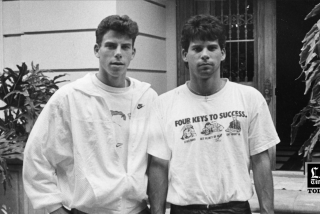Ramirez Guilty on All Night Stalker Murder Charges
Richard Ramirez, whose murderous crime rampage four years ago terrorized Southern California and baffled police for months, was found guilty Wednesday of all 43 Night Stalker crimes, including 13 murders. The verdict raises the possibility of a death sentence.
Before the verdicts were read, the sullen, 29-year-old defendant asked for, and was granted, permission to leave the packed courtroom, which included several relatives of his murder victims. He heard the verdicts--a virtual clean sweep for the prosecution--through a speaker in a holding cell.
The Los Angeles Superior Court jury of seven women and five men, which deliberated for 22 days, next must decide whether to condemn the devil-worshiping drifter from El Paso to die in the gas chamber at San Quentin or order him imprisoned for life without parole.
As he was taken from the courthouse, Ramirez flashed a two-finger “devil sign” to photographers. Asked what he thought about the verdicts, he issued a one-word comment: “Evil.”
Daniel V. Hernandez, Ramirez’s chief counsel, said “Richard wasn’t surprised” by the verdicts. Ramirez, he said, has felt for several weeks now that the jury could not be fair or objective in its deliberations.
“I’m disappointed,” added Ray G. Clark, Hernandez’s co-counsel. “I felt that we had raised a reasonable doubt.”
After the court adjourned, Los Angeles Deputy Dist. Atty. P. Philip Halpin commented: “Thank God this phase is over.”
Co-prosecutor Alan S. Yochelson said he would begin immediately calling the relatives of Ramirez’s victims to inform them of the verdicts. “I hope they can find some relief in that,” he said.
A woman who was raped in an August, 1985, attack in Mission Viejo, for which Ramirez still faces trial, said of the Los Angeles jury’s verdict: “It feels good to know justice has been done, but it doesn’t change what’s happened . . . to me or to the other victims, or put our lives back the way they were.”
Chief Deputy Dist. Atty. James G. Enright, who would be the prosecutor in the Orange County case, said that if death penalty verdicts are returned in the Los Angeles cases, he might drop prosecution of Ramirez to spare the victim further trauma from what would be a lengthy, and costly, trial. During that attack, the woman’s then-boyfriend was shot three times in the head and still is undergoing intensive therapy.
In the verdicts, Halpin and Yochelson got everything they asked for, except for one murder count, in which the jury returned a guilty verdict of second-degree rather than first-degree murder. That involved the March 17, 1985, murder of Tsai-Lian Victoria Yu, who was shot to death in her car on Alhambra Avenue in Monterey Park.
But Halpin and Yochelson called that determination “amazingly sophisticated” because, they said, the jurors had been smart enough to determine that the murder had occurred without premeditation or deliberation.
“It shows they were paying very close attention to both the evidence and the jury instructions,” Yochelson said.
After court was adjourned, the prosecutors advised the relatives of Ramirez’s victims who were on hand to refrain from commenting to the news media, since the penalty phase still lies ahead.
But two of them, Ellen Francis and Judith Arnold, the daughters of Maxon and Lela Kneiding, who lived in Glendale, said they intended to visit their parents’ grave sites. The women had struggled visibly to choke back tears as Judge Michael A. Tynan read the guilty verdicts for the murders of their parents.
In all, the jury returned with 19 “special circumstances,” such as the commission or attempted commission of a burglary in addition to a murder. Each such “special circumstance” makes Ramirez subject to the death penalty.
It took court clerk Josephine Williams and Tynan about 45 minutes to read the verdicts.
The so-called penalty phase of the trial is to begin Wednesday morning. Ramirez’s lawyers are expected to start calling witnesses whose testimony is intended to persuade jurors to spare Ramirez’s life.
Rebuttal Weighed
Halpin said he does not intend to call prosecution witnesses during this phase, except perhaps as rebuttal witnesses after the defense case is over.
Most of the Night Stalker crimes were committed during pre-dawn residential burglaries throughout Los Angeles County and were marked by cold-blooded murders, savage beatings, mutilations and sexual assaults.
The crimes were especially chilling because they seemed so indiscriminate.
The victims were middle-class men and women who lived peacefully in neatly tended houses and condominiums and had simply gone to bed with a window or door unsecured on a warm, benign California night.
Among Ramirez’s victims were a traffic supervisor, an accountant, a lawyer, a student, a pizzeria owner, a parking lot attendant, an auto mechanic. Some were grandparents. One was a church deacon.
Widespread Fear
The wave of random and brutal slayings generated widespread fear throughout Southern California once police disclosed the existence of a wanton serial killer on Aug. 8, 1985.
Sales of guns, ammunition, locks and window bars rose sharply all over the county. In the weeks leading up to Aug. 31, the day Ramirez was caught by citizens in East Los Angeles, employees of gun shops and home-security stores often arrived for work in the morning to find customers waiting at their doors.
Even police officers were spooked by the killings. One senior member of the region-wide police Night Stalker task force became so concerned that he moved his family out of their San Gabriel Valley house during the manhunt.
Various government agencies eventually offered about $80,000 in reward money for information leading to the killer’s arrest and conviction. Nearly 20 claims already have been filed and now can be processed.
All but one attack occurred between mid-March and early August of 1985. Several of them took place within hours and blocks of one another.
Initially, many weeks passed before investigators realized that the lack of a pattern was one of Ramirez’s trademarks. His modus operandi did not fit neatly into the traditional categories that police had come to associate with serial criminals.
Even as the killings continued, however, investigators gradually began to recognize the Night Stalker’s various “signatures”--distinctive and gaping stab and slash wounds to the throat or body; the familiar language that Ramirez used in demanding loot; his use of ligatures and restraints, including handcuffs and thumb cuffs; and unusual Avia shoe prints at many of the crime scenes, including a bloody print on a murder victim’s face.
Ramirez often severed the telephone wires after gaining entry.
In nearly all the attacks, he quickly dispatched any adult males with a gunshot to the head. Then he ransacked the homes and assaulted the women, sometimes in the same room where their husbands lay dead. A Northridge man who survived a gunshot still carries Ramirez’s bullet in his head.
Trademark Pentagram
Another Ramirez trademark was the pentagram, which first appeared in the remote Monrovia home of Mabel Bell and Florence Lang, drawn on a bedroom wall and on the thigh of one of the women. In a Sun Valley attack, he repeatedly ordered a woman to “swear upon Satan” as he looted her home and raped and sodomized her after killing her husband.
The pentagrams--inverted, five-pointed stars inside circles, associated with devil worship--also were found later on the dashboard of a car driven by Ramirez and on his arm. In jail, he drew a pentagram on the cell floor, apparently in his own blood. Ramirez also flashed a pentagram drawn on his palm once in open court, yelling, “Hail Satan!”
The Avia tennis shoes were never found. But prosecutors linked the shoe prints to Ramirez by introducing evidence from a Monrovia burglary on May 9, 1985, in which police identified not only the shoe prints but also a Ramirez palm print--on the kitchen counter beneath an open window. Ramirez was not charged in that incident.
In all, four handguns were used in the Night Stalker crimes, but only one was recovered. However, firearms tests showed that several unused bullets in a bag that Ramirez had left at the downtown Greyhound bus depot once had been loaded into the gun that was used in Night Stalker attacks in Northridge and Diamond Bar.
Eventually, about 375 pieces of jewelry and other personal property taken from eight of the crime scenes were recovered and linked to Ramirez.
In addition to the burglaries and murders, Ramirez also is suspected of kidnaping and sexually assaulting as many as a dozen children, some as young as 6, although he was never charged with those crimes, according to Sgt. Frank Salerno, the Los Angeles County sheriff’s homicide detective who directed the Night Stalker task force.
Officials also believe that Ramirez murdered a 14th person in Los Angeles County: Patti Higgins, a 32-year-old special education teacher who was found in her Arcadia apartment on June 27, 1985, with her throat slashed. That charge was dropped before trial because of lack of evidence.
As for the 43 felony counts on which Ramirez was tried, the outcome never seemed in much doubt, given the wealth of direct and circumstantial evidence against Ramirez, which also included self-incriminating statements he made after arrest.
In all, eight eyewitnesses--including six surviving women--either identified Ramirez as their assailant or placed him at a crime scene.
Jury selection began on July 21, 1988, nearly three years after Ramirez’s arrest. The case went to the jury last July 26, after more than 165 witnesses had testified and 658 exhibits were introduced.
The trial was full of twists and turns and tragedy of its own.
Juror Murdered
On Aug. 14, after 12 1/2 days of deliberations, one of the jurors, Phyllis Y. Singletary, was found murdered in her Carson apartment, the victim of a domestic quarrel with her boyfriend, James C. Melton. Melton committed suicide the next day.
Singletary’s murder traumatized many of the remaining jurors and eight alternates, raising questions as to whether they would be emotionally capable of carrying on.
But Judge Tynan gave jurors a day off and ordered deliberations to begin anew after a disconsolate alternate was named to take Singletary’s place.
That was the second false start in jury deliberations.
Earlier, one of the jurors fell asleep twice during the second week of deliberations, prompting Tynan on Aug. 11 to dismiss him and replace him with another alternate. It was the following Monday morning that Singletary was slain.
Daniel and Arturo Hernandez, Ramirez’s initial defense lawyers, frustrated Judge Tynan and prosecutor Halpin with maneuvers that repeatedly delayed the proceedings. Halfway through the trial, Tynan appointed the third lawyer, Clark, to assist the team.
The 14-month trial would have ended much sooner had Ramirez’s lawyers taken their client’s advice.
After the prosecution rested its case, Ramirez did not want to mount a defense. But his lawyers prevailed, ultimately calling 38 witnesses on Ramirez’s behalf over the course of about five weeks in an attempt to imbue jurors with a reasonable doubt.
Throughout the years of court proceedings in the case, Ramirez’s courtroom behavior often has been unpredictable. He once called a witness a liar. Another time he called the judge several expletives. On another occasion, he used an object to reflect ceiling light into the face of a witness.
Yet, at other times, the shaggy-haired defendant, with his ever-present black sunglasses, has studiously followed the testimony, taking notes and conferring with members of his defense team. His feet remained shackled throughout.
Ramirez was examined in 1985 by a court-appointed psychologist, who found him to be “borderline competent” after a 10- to 15-minute discussion that was abruptly terminated by Ramirez. “I am sane,” Ramirez said at one pretrial hearing in 1985.
During the trial, prosecutors presented the 43 felony charges to jurors as 15 separate “incidents,” mostly in chronological order, buttressed by charts and maps as well as gruesome color photographs of the crime scenes and victims.
Faces More Charges
Ramirez still faces separate felony charges, including murder and attempted murder, in Orange County and in San Francisco.
His identity became known after authorities lifted a partial fingerprint from a stolen car that was linked to Ramirez’s final attack, in Mission Viejo on Aug. 25, 1985.
Working manually--and not with a laser and a state-of-the-art computer as previously reported--experts matched that print with those taken of Ramirez after his arrest in Los Angeles several years earlier on a misdemeanor traffic violation.
Once Ramirez’s identity became known, police issued an all-points bulletin for his arrest, accompanied by a mug shot. The next morning, Aug. 31, 1985, he was captured in East Los Angeles shortly after he had returned to Los Angeles from Arizona, where he was visiting a brother.
At the end, Ramirez nearly eluded the authorities.
On the morning of his arrest, about half a dozen Los Angeles undercover police officers--armed with Ramirez’s photograph--had staked out the downtown Greyhound bus depot, expecting the suspect to board a bus out of town.
But Ramirez managed to slip through the depot undetected, apparently because the officers had been focusing on departing passengers rather than those arriving in Los Angeles.
After Ramirez was arrested and fingerprinted, Los Angeles police also linked him to the murder of a 79-year-old Glassell Park woman in June of 1984 by identifying two of his fingerprints--previously unidentified--on a window screen that had been removed to gain entry to the woman’s ground-floor apartment.
Ramirez was allowed to leave the courtroom before the verdicts were read despite prosecution objections. Tynan excused Ramirez, saying he feared that the defendant would disrupt the proceedings.
VICTIM’S VIGIL--Richard Ramirez may escape prosecution in Orange County attacks. Page 31.
RAMIREZ CASE CHRONOLOGY 1985 Aug. 31--Richard Ramirez is arrested, booked and taken to Central Jail. Sept. 3--He is arraigned in Los Angeles Municipal Court. Sept. 5--At two separate police lineups, numerous witnesses identify Ramirez as the Night Stalker. Oct. 24--Defendant pleads not guilty, yelling “Hail Satan” as he is led from the courtroom. 1986 March 3--Preliminary hearing begins in Municipal Court. May 6--After 143 witnesses and 531 exhibits, Judge James Nelson orders Ramirez to stand trial in Superior Court on murder, attempted murder, burglary, rape, oral copulation and sodomy charges. May 21--Ramirez pleads not guilty. Dec. 2--Superior Court Judge Michael Tynan is assigned to the case. 1987 Nov. 23--At prosecution’s request, Tynan dismisses one of the 14 murder counts against Ramirez. 1988 July 21--Jury selection begins. 1989 Jan. 23--From a panel of nearly 1,600 L.A. County residents, 12 jurors and 12 alternates are chosen and sworn in. Jan. 30--Trial begins with prosecution’s opening statement. The first of more than 165 witnesses testifies. May 2--Prosecution rests. May 9--Defense opens case. July 12-25--Closing arguments by both sides. July 26--Judge instructs jurors who begin deliberating, taking with them more than 8,000 pages of trial transcripts and 655 exhibits. Sept. 20--Ramirez is convicted of 13 murders and 30 other felonies. Jurors also find that special circumstances existed, making Ramirez eligible for the death penalty.
KEY PLAYERS IN STALKER TRIAL MICHAEL A. TYNAN, 52--Superior Court judge since 1984. Somewhat impatient by nature, he has managed the case with forebearance and humor, several times making rulings that have avoided mistrials. P. PHILIP HALPIN, 52--The no-nonsense, career prosecutor has clashed repeatedly with opposing counsel while working overtime to correct or avoid defense mistakes in hopes of avoiding appellate reversal. ALAN S. YOCHELSON, 34--He joined district attorney’s office eight years ago. Was ecstatic when assigned as the Night Stalker co-prosecutor. Friendly, easy-going. He handled blood and scientific evidence skillfully. DANIEL V. HERNANDEZ, 44--A late-comer to the legal profession, enrolling in law school at age 33. Has struggled mightily through his first death-penalty case. Often chided by Tynan for shortcomings. RAY G. CLARK, 58--A folksy, plain-speaking lawyer. Appointed by Tynan in mid-trial to assist Hernandez. A quick study, but he never seemed to fully grasp the enormous amount of details and evidence in the case. FRANK SALERNO, 50--Sheriff’s Department homicide detective. Avid outdoorsman. Led the Night Stalker task force. Has attended trial religiously. One Night Stalker incident occurred near his home.
More to Read
Sign up for Essential California
The most important California stories and recommendations in your inbox every morning.
You may occasionally receive promotional content from the Los Angeles Times.










